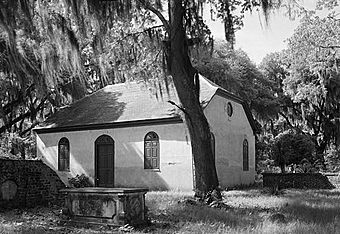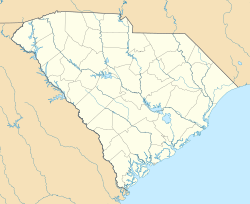Strawberry Chapel and Childsbury Town Site facts for kids
Quick facts for kids |
|
|
Strawberry Chapel
|
|

Strawberry Chapel
|
|
| Location | Berkeley County, South Carolina |
|---|---|
| Nearest city | Goose Creek / Moncks Corner |
| Built | 1707 (Childsbury) 1725 (Chapel) |
| NRHP reference No. | 72001194 |
| Added to NRHP | April 26, 1972 |
Strawberry Chapel is a historic church building in Berkeley County, South Carolina. It was built in 1725. This chapel is located on Strawberry Chapel Road, close to the West Branch of the Cooper River. Next to the chapel's land is the historic site of the "Town of Childsbury." This was a planned community started in 1707, but the town no longer exists today. Both Strawberry Chapel and the Childsbury site were added to the National Register of Historic Places on April 26, 1972.
The chapel, its graveyard, and the surrounding land are private property. They are usually only open to the public for special events and annual church services.
Contents
History of Strawberry Chapel
The story of Strawberry Chapel begins with James Child. He was an English settler who received a large piece of land. This land was about 1,200 acres (486 hectares) on Strawberry Bluff. It overlooked the Cooper River. This spot was important because it was as far upstream as ships could travel. James Child also started a ferry service across the river here.
A town called Childsbury was planned for this bluff. At one time, Childsbury had many buildings. These included a tavern, a school, a chapel, and a general store. There was even a race track. People like tanners, butchers, shoemakers, and carpenters lived there. However, nearby plantations grew much larger and more important. Because of this, the town of Childsbury slowly faded away. By 1750, only the chapel and the tavern were still in regular use. Fairs continued to be held there until the mid-1750s.
Strawberry Chapel was known as a "chapel of ease." This meant it was a smaller church built for people who lived far from the main parish church. The main church for this area was Biggin Church, about 10 miles (16 km) away. Being a "parochial" chapel meant Strawberry Chapel had special permission. It could perform important ceremonies like baptisms and burials.
By 1825, Strawberry Chapel became the main parish church. It took over this role from Biggin Church. Today, the area where the town of Childsbury once stood is a South Carolina Heritage Preserve. This means it is protected for its historical importance.
Town Plan of Childsbury
The town of Childsbury was carefully planned out. It was designed to have 24 blocks on Strawberry Bluff. In the very center of the town was a market square. There were also two other squares. These were named Child's Square and Dixe's Square. The streets in the town were quite wide, about 66 feet (20 meters) across.
Specific areas were set aside for important community buildings. These included land for a college, a free school, a church, and a house for the minister. James Child also set aside 600 acres (243 hectares) for farms and pastures. Another 100 acres (40 hectares) on the bluff were planned for a future fort, or "citadel." A drawing of this town plan has been shared in books and other publications.
Chapel Architecture and Features
Strawberry Chapel is a simple, rectangular building made of brick. Its outside is covered in stucco. The roof is a special type called a "jerkin-head roof." The front of the chapel faces south. It has a double door with three panels. Above the door is a rounded window called a "fanlight." There are windows with shutters on both sides of this main door.
The west side of the chapel has a single door. It is flanked by two windows. Above these, there is a decorative round window called a "rosette window." The east side of the chapel has two windows, also with a rosette window above them. A small room extends from the north wall. This room is called a "vestry." It is used by the clergy and for storing church items.
Inside the chapel, there is a special stone tablet. This tablet remembers an early minister of the parish. It was moved to Strawberry Chapel from Biggin Church. The silver Communion service from Biggin Church has an interesting story. It was hidden during the Civil War. In 1947, it was found buried in a barn at the Comingtee Plantation. This silver service is not used during services at Strawberry Chapel. Instead, it is on loan to the Charleston Museum for safekeeping and display.
The chapel has undergone a major restoration project. This project was completed by 2025, just in time for the chapel's 300th Anniversary.
Management and Public Access
Strawberry Chapel is managed by descendants of the Ball, Harleston, Waring, and Stoney families. These families work hard to protect the historic 1725 building and its graves. A big renovation project was completed by the chapel's 300th Anniversary in 2025. Work began in 2018 to dry out the chapel walls, which had been affected by water for many years.
Four communion services are held at the chapel each year. Visitors are welcome to attend these services. However, it is important to remember that Strawberry Chapel and its burial grounds are on private property. They are not open to the public for general visits.
The chapel and its graveyard share a property line with the historic Childsbury Township land. But they are completely separate. The historic Childsbury Township property is owned by the State of South Carolina. It is open to the public. This state-owned section is not part of Strawberry Chapel's private property.



